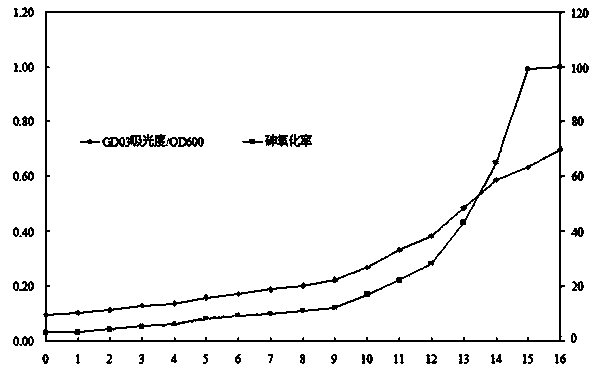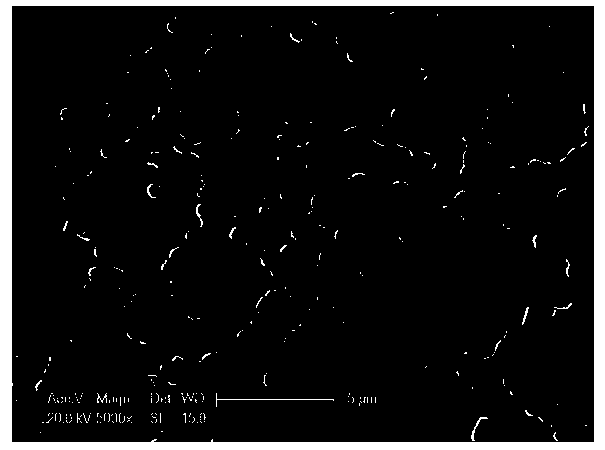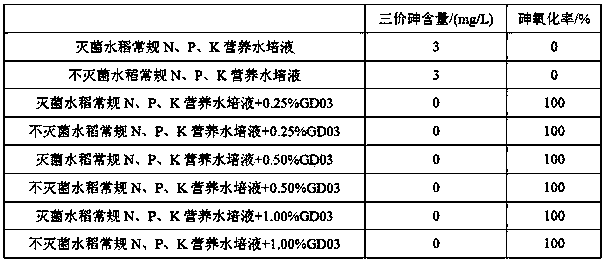Achromobacter xylosoxidans and application thereof
A colorless bacillus and xylose technology, applied in the field of environmental microorganisms, can solve the problems of secondary pollution, high cost of chemical oxidation/reduction, and insufficient efficiency, and achieve strong resistance and adaptability, easy to be removed by adsorption, and strong mobility sexual effect
- Summary
- Abstract
- Description
- Claims
- Application Information
AI Technical Summary
Problems solved by technology
Method used
Image
Examples
Embodiment 1
[0016] Example 1: Isolation of Achromobacter xylosoxidans GD03 from arsenic-contaminated simulated soil
[0017] The experimental soil was taken from the surface soil of a rice field soil in Fuzhou City, Fujian Province, and NaAsO was added at the ratio of 1 g As(III) / kg soil 2 , After mixing well, place it in the dark for 3 months to obtain a simulated soil sample of arsenic pollution. The specific operation steps are as follows:
[0018] (1) Enrichment of arsenic-resistant bacteria: accurately weigh 1 g of arsenic-contaminated simulated soil sample into a 150 ml Erlenmeyer flask containing 25 mg As(III) / L sterile enrichment medium, and culture at 30°C on a shaker (128 rpm) for one week, observe the growth of the strain. When the medium appears turbid, it is sequentially inoculated into the next enriched medium with a higher As(III) concentration at a ratio of 10% (volume ratio). The As(III) concentration is 50 mg / L and 100 mg / L, respectively. L, 150 mg / L, 200 mg / L, 400 mg / L to ...
Embodiment 2
[0025] Example 2: Arsenic oxidation curve of Achromobacter xylosoxidans GD03
[0026] Pick a single clone of Achromobacter xylosoxidans GD03, inoculate it into 100ml of the optimal liquid medium E containing 100mgAs(III) / L, place it in a shaker at 28°C for 48 hours with shaking, and draw from it at 5% of the inoculum 5ml to 100ml of fresh optimal liquid medium E containing 150mgAs(III) / L, culture in a shaker at 28℃ for 24 hours, and then draw 5ml to 100ml of fresh optimal liquid culture containing 200mgAs(III) / L In base E, place it in a shaker at 28°C and shake for 24 hours. At this time, the OD of GD03 600 It is about 0.8, stored in a refrigerator at 4°C and used as seed bacterial solution for inoculation. Draw 5ml to 100ml of fresh optimal liquid medium E containing 1000mgAs(III) / L with a 5% inoculum amount, and place it in a shaker at 28°C for 9 hours and start sampling, every 1 hour Take one sample until As(III) is completely oxidized, take 1.2ml and 0.5ml each time, and me...
Embodiment 3
[0027] Example 3: Oxidation effect of Achromobacter xylosoxidans GD03 on trivalent arsenic in simulated arsenic-contaminated rice hydroponics
[0028] Using conventional rice N, P, K nutrient hydroponics (containing N 23mg / L, P 7mg / L, K 21mg / L) as a control, referring to my country’s maximum arsenic-contaminated groundwater level is about 2-3 mg / L, Add NaAsO to rice hydroponic nutrient solution 2 To make the trivalent arsenic concentration in the hydroponic solution reach 3mg / L, design different inoculation ratios of Achromobacter xylosoxidans GD03 in the rice hydroponic nutrient solution, and investigate the oxidation effect of GD03 on trivalent arsenic. The specific method is as follows: prepare 8 250ml Erlenmeyer flasks, 4 for 100ml conventional rice N, P, K nutrient hydroponics (sterilized at 121℃ for 20 minutes), and the other 4 for 100ml non-sterilized rice conventional N, P , K nutrient hydroponics, according to the inoculation ratio (volume ratio) of 0%, 0.25%, 0.50% and ...
PUM
 Login to View More
Login to View More Abstract
Description
Claims
Application Information
 Login to View More
Login to View More - R&D
- Intellectual Property
- Life Sciences
- Materials
- Tech Scout
- Unparalleled Data Quality
- Higher Quality Content
- 60% Fewer Hallucinations
Browse by: Latest US Patents, China's latest patents, Technical Efficacy Thesaurus, Application Domain, Technology Topic, Popular Technical Reports.
© 2025 PatSnap. All rights reserved.Legal|Privacy policy|Modern Slavery Act Transparency Statement|Sitemap|About US| Contact US: help@patsnap.com



